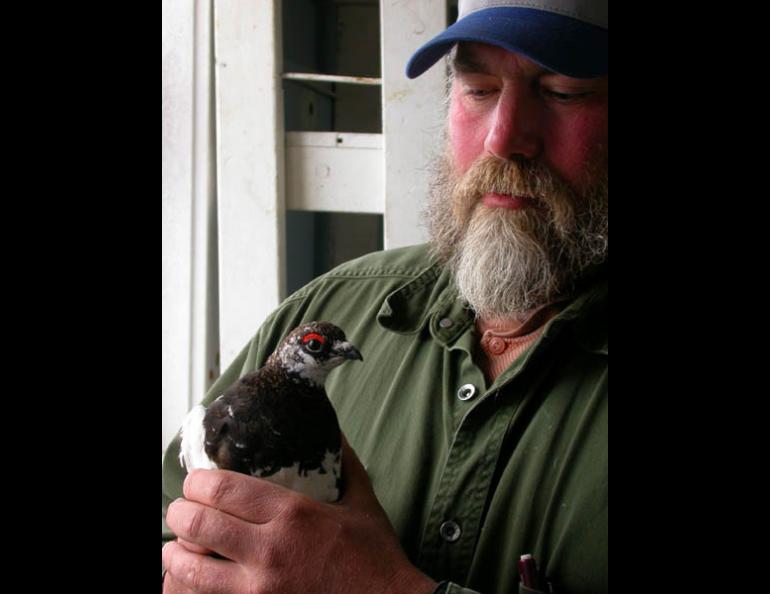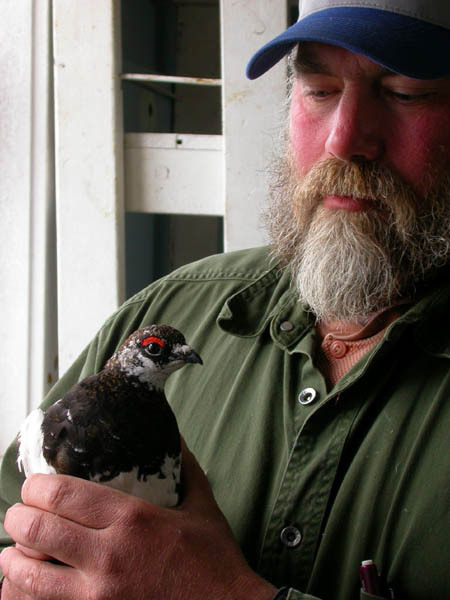
Ptarmigan pioneers island-hop in Aleutians
ATTU—Crawling through long grass with a set of wire cutters clenched in his teeth, Clait Braun extended a long fiberglass pole toward a ptarmigan. Adjusting for gusts of wind, Braun eased a small wire noose over the bird’s lower neck, then tugged. A few seconds later, he cradled a flapping ptarmigan in his hands.
“He’s a big, strong, chunky bird,” Braun said as he tucked the ptarmigan inside a white cotton bag. “Really good body mass. I love it.”
Braun, 64, is a wildlife biologist from Tucson, Arizona and one of North America’s leading experts on grouse and ptarmigan. He traveled to this remote island—the westernmost point in Alaska at the tail end of the Aleutian chain—to catch a rare subspecies of ptarmigan. Braun and a small team of biologists and volunteers were participating in a U.S. Fish and Wildlife Service program to move a few birds from Attu to the neighboring island of Agattu, 30 miles across the swells of the northern Pacific. After team members captured 27 Evermann’s rock ptarmigan in one week, they sailed the birds across Attu Strait in the research ship Tiglax, following 26 ptarmigan transplanted to the 55,535-acre island of Agattu the year before.
The leader of the project to restock Agattu with Evermann’s rock ptarmigan is Wildlife biologist Steve Ebbert of the Alaska Maritime National Wildlife Refuge in Homer. He spent a week on Attu snaring ptarmigan with Braun, Alaska wildlife veterinarian Bill Taylor and volunteer Pat Pourchot in an attempt to turn back the clock in the western Aleutians.
Evermann’s rock ptarmigan formerly lived on all of the Near Islands in the Aleutians, which include Attu, Agattu, Shemya, Alaid and Nizki. The birds disappeared on every island except Attu after Russian and American fur trappers introduced arctic foxes to the islands in the 1800s. The non-migratory ptarmigan may have survived on Attu because the mountainous terrain provided a refuge from foxes, which prefer to hunt near shoreline, Ebbert said.
The Evermann’s variety of ptarmigan is unique to Attu, differing from other varieties of Alaska’s state bird by its color and genetic makeup. Males have heads as black as Oreo cookies and brilliant red combs over their eyes; females are also darker than other Alaska ptarmigan.
The U.S. Fish and Wildlife Service, which manages the Alaska Maritime National Wildlife Refuge, has had a program since 1949 to remove foxes from the Aleutian Islands. Since then, refuge staff and wildlife specialists from the U.S. Department of Agriculture have trapped and killed all the foxes on up to 41 islands, including Attu (in 1999), and Agattu (in the 1970s). Foxes were gone from Agattu and the treeless island was once again safe for ground-nesting ptarmigan, but in the 40 years after the foxes left, refuge managers found no ptarmigan there.
Ebbert and his colleagues have given the birds a nudge toward recovery aboard using the U.S. Fish and Wildlife Service’s research ship, the Tiglax. During several four-hour trips, the ship carried 27 birds to Agattu in early June 2004, and, after biologists and crewmembers carried them ashore, the birds exploded away from their carrying crates into the golden tundra of their new home.
“We hope they survive and reproduce like they did in the 1800s,” Ebbert said.
The Aleutians, unpopulated and now protected as part of the wildlife refuge, offer a unique chance to restore an ecosystem to what it was before people lived there, Ebbert said. Plants on the islands are all native, and with the removal of arctic foxes, birds such as the Aleutian Canada goose have rebounded from the Endangered Species list. Ebbert hopes the Evermann’s rock ptarmigan will once again fill Agattu with its raspy, belching calls as the transplants from Attu multiply.
“What we’re about is restoring these islands to their natural biodiversity,” Ebbert said. “The ptarmigan project is a natural progression from the fox eradication project.”





